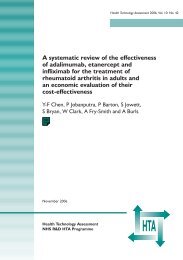Measuring Athlete Imagery Ability: The Sport ... - ResearchGate
Measuring Athlete Imagery Ability: The Sport ... - ResearchGate
Measuring Athlete Imagery Ability: The Sport ... - ResearchGate
Create successful ePaper yourself
Turn your PDF publications into a flip-book with our unique Google optimized e-Paper software.
438 Williams and Cumming<br />
Byrne, B.M. (2010). Structural equation modeling with AMOS: basic concepts, applications,<br />
and programming (2nd ed.). New York: Taylor and Francis.<br />
Callow, N., & Hardy, L. (2001). Types of imagery associated with sport confidence in netball<br />
players of varying skill levels. Journal of Applied <strong>Sport</strong> Psychology, 13, 1–17.<br />
Callow, N., & Waters, A. (2005). <strong>The</strong> effect of kinesthetic imagery on the sport confidence<br />
of flat-race horse jockeys. Psychology of <strong>Sport</strong> and Exercise, 6, 443–459.<br />
Campos, A., Pérez-Fabello, M.J., & Gómez-Juncal, R. (2004). Gender and age differences<br />
in measured and self-perceived imaging capacity. Personality and Individual Differences,<br />
37, 1383–1389.<br />
Cheung, G.W., & Rensvold, R.B. (2002). Evaluating goodness-of-fit indexes for testing<br />
measurement invariance. Structural Equation Modeling, 9, 233–255.<br />
Costello, A.B., & Osborne, J.W. (2005). Best practices in exploratory factor analysis: Four<br />
recommendations for getting the most from your analysis. Practical Assessment.<br />
Research Evaluation, 10, 1–9.<br />
Cudeck, R., & Brown, M.W. (1983). Cross-validation of covariance structures. Multivariate<br />
Behavioral Research, 18, 147–167.<br />
Cumming, J. (2008). Investigating the relationship between exercise imagery, leisure time<br />
exercise behavior, and self-efficacy. Journal of Applied <strong>Sport</strong> Psychology, 20, 184–198.<br />
Cumming, J., Clark, S.E., Ste-Marie, D.M., McCullagh, P., & Hall, C. (2005). <strong>The</strong> Functions<br />
of Observational Learning Questionnaire. Psychology of <strong>Sport</strong> and Exercise, 6, 517–537.<br />
Cumming, J., & Hall, C. (2002). <strong>Athlete</strong>s’ use of imagery in the off-season. <strong>The</strong> <strong>Sport</strong><br />
Psychologist, 16, 160–172.<br />
Cumming, J., & Ramsey, R. (2009). <strong>Sport</strong> imagery interventions. In S. Mellalieu & S. Hanton<br />
(Eds.), Advances in applied sport psychology: A review (pp. 5–36). London: Routledge.<br />
Cumming, J., Olphin, T., & Law, M. (2007). Self-reported psychological states and physiological<br />
responses to different types of motivational general imagery. Journal of <strong>Sport</strong><br />
& Exercise Psychology, 29, 629–644.<br />
Cumming, J., & Ste-Marie, D.M. (2001). <strong>The</strong> cognitive and motivational effects of imagery<br />
training: A matter of perspective. <strong>The</strong> <strong>Sport</strong> Psychologist, 15, 276–287.<br />
Glisky, M. L., Williams, J. M., & Kihlstrom, J. F. (1996). Internal and external imagery<br />
perspectives and performance on two tasks. Journal of <strong>Sport</strong> Behavior, 19, 3–18.<br />
Goss, S., Hall, C., Buckolz, E., & Fishburne, G. (1986). <strong>Imagery</strong> ability and the acquisition<br />
and retention of movements. Memory & Cognition, 14, 469–477.<br />
Gregg, M., & Hall, C. (2006). Measurement of motivational imagery abilities in sport.<br />
Journal of <strong>Sport</strong>s Sciences, 24, 961–971.<br />
Hair, J. F., Anderson, R. E., Tatham, R. L., & Black, W. C. (1998). Multivariate data analysis.<br />
Upper Saddle River, NJ: Prentice Hall.<br />
Hall, C.R. (1998). <strong>Measuring</strong> imagery abilities and imagery use. In J.L. Duda (Ed.), Advances<br />
in sport and exercise psychology measurement (pp. 165–172). Morgantown, WV: Fitness<br />
Information Technology.<br />
Hall, C.R. (2001). <strong>Imagery</strong> in sport and exercise. In R.N. Singer, H.A. Hausenblas, & C.M.<br />
Janelle (Eds.), <strong>The</strong> handbook of sport psychology (2nd ed., pp. 529–549). New York:<br />
John Wiley & Sons Inc.<br />
Hall, C.R., Buckolz, E., & Fishburne, G. (1992). <strong>Imagery</strong> and the acquisition of motor skills.<br />
Canadian Journal of <strong>Sport</strong> Sciences, 17, 19–27.<br />
Hall, C., Mack, D., Paivio, A., & Hausenblas, H. (1998). <strong>Imagery</strong> use by athletes: Development<br />
of the sport imagery questionnaire. International Journal of <strong>Sport</strong> Psychology,<br />
29, 73–89.<br />
Hall, C., & Martin, K. A. (1997). <strong>Measuring</strong> movement imagery abilities: A revision of the<br />
Movement <strong>Imagery</strong> Questionnaire. Journal of Mental <strong>Imagery</strong>, 21, 143–154.<br />
Hu, L., & Bentler, P.M. (1999). Cutoff criteria for fit indices in covariance structure analysis:<br />
Conventional criteria versus new alternatives. Structural Equation Modeling, 6, 1–55.
















